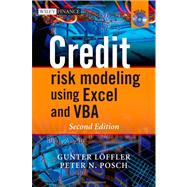- ISBN: 9780470660928 | 0470660929
- Cover: Hardcover
- Copyright: 1/31/2011
It is common to blame the inadequacy of credit risk models for the fact that the financial crisis has caught many market participants by surprise. On closer inspection, though, it often appears that market participants failed to understand or to use the models correctly. The recent events therefore do not invalidate traditional credit risk modeling as described in the first edition of the book. A second edition is timely, however, because the first dealt relatively briefly with instruments featuring prominently in the crisis (CDSs and CDOs). In addition to expanding the coverage of these instruments, the book will focus on modeling aspects which were of particular relevance in the financial crisis (e.g. estimation error) and demonstrate the usefulness of credit risk modelling through case studies.This book provides practitioners and students with an intuitive, hands-on introduction to modern credit risk modelling. Every chapter starts with an explanation of the methodology and then the authors take the reader step by step through the implementation of the methods in Excel and VBA. They focus specifically on risk management issues and cover default probability estimation (scoring, structural models, and transition matrices), correlation and portfolio analysis, validation, as well as credit default swaps and structured finance.Contents (updates and changes in bold)1. Estimating Credit Scores with Logit Additional section on credit scoring in the mortgage market and its role in the development of the subprime crisis2. The structural approach to Default Prediction and valuation Additional section showing how to implement a widely used alternative modelling approach (CreditGrades). New case study on the evolution of a banks default risk before default (Lehman)3. Transition Matrices Explanation on the transition behaviour of structured finance ratings.4. Prediction of Default and Transition Rates Update of the prediction case study to include 2007-2009 and discussion of the performance of such prediction models during the subprime crisis.5. Modeling and estimating Default correlations with the Asset Value Approach Explanation of precision of the estimates.6. Measuring Credit portfolio Risk with the Asset Value Approach New section on how to deal with low precision in input parameters7. Validation of Rating Systems Updated with notes on the recent criticism of rating agencies8. Validation of Credit Portfolio Models No update9. Risk Neutral Default Probabilities and Credit default Swaps More detailed explanation of CDS and the use of CDS in practice and valuation . Demonstration of hedging and trading strategies based on CDS and bond trading.10. Risk Analysis of Structured Credit Extend the chapter to include pricing of CDO's. Expansion of risk analysis through discussion of the ratings of structured finance securities and their role in the financial crisis and the precision and reliability of risk estimates. The analysis of First to Default swaps will be extended to typical Credit Linked Note products.11. Basel II and Internal ratings Inclusion of explanation of regulatory deficits revealed by the subprime crisis.







